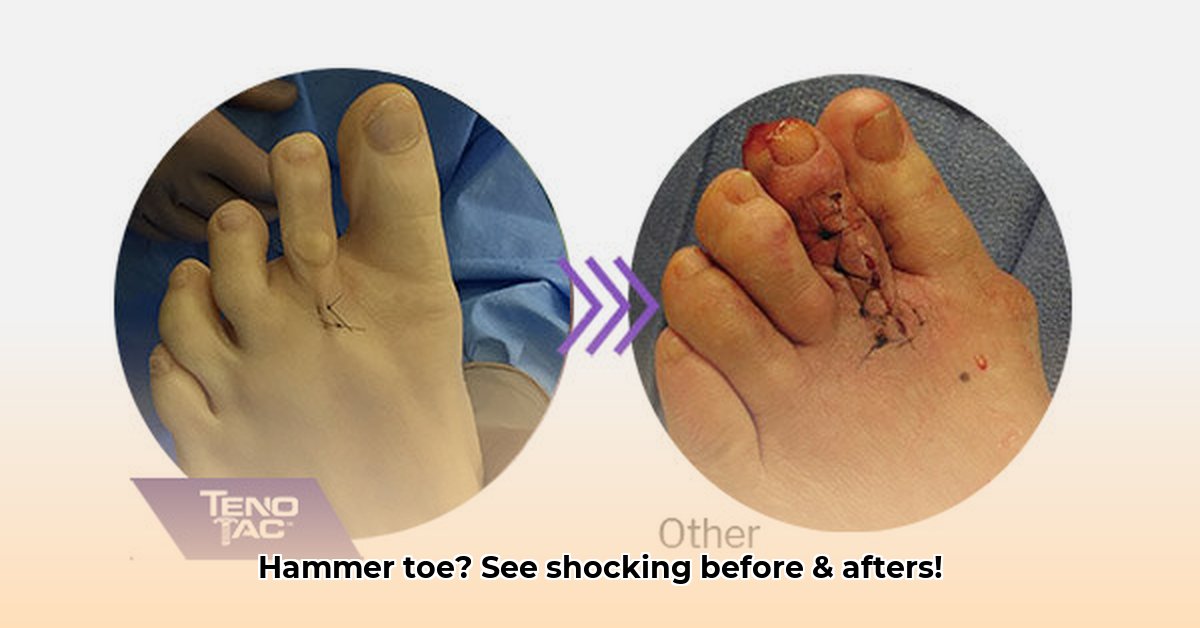Do you have a bent toe that’s causing you pain? You’re not alone! Many people struggle with hammertoes, and this guide will show you what you can do about it. We’ll break down everything from simple home remedies to surgery, complete with real “before and after” photos of people who’ve successfully treated their hammertoes. You’ll learn about all the choices, from comfy shoes and special inserts to more involved procedures, so you can make the best decision for your feet. We’ll also cover what to expect during recovery, so you can feel confident about your treatment plan. For more on foot development, see this helpful guide on [foot growth plates](https://mearnes.com/growth-plates-of-the-foot/). Let’s get those toes straightened out!
Hammer Toes Pictures Before & After: A Comprehensive Treatment Guide
Let’s talk about hammertoes – those bent toes that can cause a surprising amount of discomfort and affect your quality of life. We’ll explore your options for fixing this common foot problem, including before-and-after photos to illustrate potential treatment outcomes.
What Exactly is a Hammertoe?
A hammertoe is a deformity that affects the second, third, or fourth toes. It causes the toe to bend at the middle joint, resembling a hammer. This bend can become rigid over time, leading to pain and discomfort. Anyone can develop a hammertoe, but it’s more common as we age.
Causes and Risk Factors for Hammertoes
Hammertoes develop due to a variety of factors that disrupt the normal balance of muscles and tendons in the foot. These factors can include:
- Muscle Imbalance: An imbalance in the muscles of the foot can cause the toe to bend.
- Improper Footwear: Wearing shoes that are too tight, narrow, or have high heels can force the toes into a bent position.
- Foot Structure: Certain foot structures, such as high arches or flat feet, can increase the risk of developing a hammertoe.
- Injury: Trauma to the toe can sometimes lead to the development of a hammertoe.
- Underlying Conditions: Conditions like arthritis and diabetes can increase the risk of hammertoes.
Recognizing the Symptoms of a Hammertoe
The most obvious sign of a hammertoe is the visible bend in the middle joint of the affected toe. Other symptoms may include:
- Pain in the affected toe, especially when wearing shoes
- Stiffness in the toe joint
- Difficulty moving the toe
- Corns or calluses on the top of the toe or on the ball of the foot
- Inflammation and redness
If you experience any of these symptoms, it’s important to seek medical attention.
Getting a Diagnosis: The First Step to Recovery
The first step toward treating a hammertoe is getting an accurate diagnosis from a podiatrist. A podiatrist will conduct a thorough examination of your foot, assess the flexibility of your toe, and discuss your symptoms and medical history. They may also take X-rays to evaluate the underlying bone structure and rule out other conditions.
Non-Surgical Treatment Options for Hammertoes
In many cases, non-surgical treatments can effectively manage hammertoe symptoms and prevent the condition from worsening. These options include:
- Proper Footwear: Choosing shoes with a wide toe box and adequate cushioning can provide relief by reducing pressure on the affected toe. Avoid high heels and shoes with pointed toes.
- Orthotics: Custom or over-the-counter orthotic devices can help support the arch of the foot, improve alignment, and alleviate pressure on the hammertoe.
- Padding and Strapping: Applying padding or cushions to the affected toe can protect it from rubbing against shoes. Strapping the toe in a straightened position can also provide support and reduce pain.
- Stretching Exercises: Regular stretching exercises can help improve flexibility in the toe and prevent stiffness. Your podiatrist can recommend specific exercises tailored to your needs. A simple exercise involves gently pulling the toe straight and holding it for 30 seconds, repeating several times a day.
- Medications: Over-the-counter pain relievers, such as ibuprofen or naproxen, can help manage pain and inflammation. In some cases, your doctor may prescribe stronger pain medications or cortisone injections.
While these non-surgical treatments can provide relief and improve the appearance of the toe, they may not correct the underlying deformity.
Surgical Treatment Options for Hammertoes
When non-surgical treatments fail to provide adequate relief, surgery may be necessary to correct the hammertoe. There are several surgical procedures available, and the best option will depend on the severity of the deformity and the individual’s overall health.
- Tendon Transfer: This procedure involves rerouting tendons to help straighten the toe.
- Joint Resection: In this procedure, the end of the bone at the affected joint is removed to allow the toe to straighten.
- Fusion: For severe cases, a fusion procedure may be recommended. This involves fusing the bones of the joint together, creating a solid, straight toe.
- Minimally Invasive Surgery: Minimally invasive techniques involve smaller incisions and specialized instruments to correct the deformity with minimal tissue damage.
What to Expect During Hammertoe Surgery (A General Overview):
- Anesthesia: You’ll receive either local anesthesia (numbing the foot) or general anesthesia (being put to sleep) before the procedure starts.
- Incision: The surgeon makes an incision to access the affected joint. The size and location of the incision will depend on the type of procedure being performed.
- Correction: The surgeon corrects the deformity by cutting or realigning tendons, removing bone, or fusing the joint.
- Closure: The incision is closed with stitches, and a bandage is applied.
- Recovery: After surgery, you’ll need to rest, elevate your foot, and follow your doctor’s instructions for wound care. You may also need to wear a special shoe or boot to protect your foot during healing.
Surgical vs. Non-Surgical: Weighing the Pros and Cons
Here’s a quick comparison to help you understand the trade-offs:
| Treatment Method | Advantages | Disadvantages |
|---|---|---|
| Non-Surgical | Less invasive, less expensive, quicker recovery, can be done at home | May not work for severe cases; relief may not be permanent; doesn’t correct the deformity |
| Minimally Invasive Surgery | Smaller incisions, faster recovery, less noticeable scarring, less pain | May not fully correct the problem; possible recurrence. |
| Traditional Surgery | Can completely correct the hammertoe; potentially long-lasting solution | More invasive procedure, longer recovery, higher risk of complications |
Choosing the Right Path: Consulting Your Podiatrist
The best treatment approach for your hammertoe will depend on several factors, including the severity of your condition, your overall health, and your personal preferences. Your podiatrist will conduct a thorough evaluation and discuss your options with you to determine the most appropriate course of action.
Recovery After Hammertoe Surgery
After hammertoe surgery, it’s important to follow your doctor’s instructions carefully to ensure proper healing. This may include:
- Resting and elevating your foot
- Applying ice to reduce swelling
- Taking pain medication as prescribed
- Wearing a special shoe or boot
- Attending physical therapy sessions
The recovery time after hammertoe surgery can vary depending on the type of procedure performed. It’s important to be patient and allow your foot to heal properly.
How to Choose Between Minimally Invasive and Traditional Hammertoe Surgery
Key Takeaways:
- Minimally invasive hammertoe surgery (MIHS) often leads to faster recovery and less discomfort than traditional surgery.
- The best surgical approach depends on the severity of your hammertoe and its flexibility.
- Conservative treatments, like special shoes or orthotics, may suffice for mild cases.
- Careful post-operative care is crucial for either surgical method.
- Discuss all your options with a podiatrist to determine the best course of action for you.
Understanding Your Hammertoe
Before we dive into surgical options, let’s talk about hammertoes. They’re those painful, bent toes that can make wearing shoes uncomfortable. The cause? A combination of factors – genetics, ill-fitting shoes, muscle imbalances, and even arthritis. Do you have a hammertoe? It’s time to find a solution.
Diagnosis: The First Step
Your podiatrist will examine your foot, discuss your symptoms, and possibly take X-rays. This thorough assessment guides treatment decisions. A clear diagnosis is essential for how to choose between minimally invasive and traditional hammertoe surgery.
Non-Surgical Approaches: A Gentle Start
For mild hammertoes, conservative approaches often work wonders. These include:
- Proper Footwear: Shoes with a wide toe box and adequate cushioning can alleviate pressure.
- Orthotics: Custom-made inserts provide support and correct biomechanical issues.
- Exercises: Stretching and strengthening exercises maintain toe flexibility.
- Medication: Pain relievers and anti-inflammatory drugs can manage discomfort.
Sometimes, these methods are all you need. Let’s see if surgery is necessary!
Surgical Solutions
- Achieve Anesthesiology Work-Life Balance: Your Guide - December 4, 2025
- Unlock Young Doctors’ Work-Life Balance: Actionable Strategies Now - December 2, 2025
- Unlock Life Harmony: Work-Life Integration Guide - November 30, 2025
















